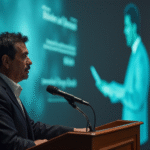Cyberattack Surge in Mexico
Mexico experienced more than 35,200 million cyberattacks in the first quarter of 2025, placing it as the second country with the highest volume of cybercriminal activity in Latin America, just behind Brazil. This information comes from the latest Global Threat Landscape Report 2025 by FortiGuard Labs, the threat intelligence arm of cybersecurity firm Fortinet.
This figure, which has been steadily increasing compared to previous years, reported 324,000 million malicious events in Mexico alone in 2024. The rising sophistication of digital threats faced by businesses, government institutions, and individual users highlights the urgent need for robust cybersecurity measures.
Artificial Intelligence in Cyberattacks
Fortinet has identified that criminal organizations are leveraging artificial intelligence (AI) to execute more targeted, hard-to-detect attacks with greater evasion capabilities against traditional defense systems. Ironically, the same AI is also becoming an essential tool for companies seeking protection.
“Generative AI enables security operations centers (SOC) and network operations centers (NOC) to anticipate potential threats and respond faster than human counterparts,” explained Sebastián Russo, Director of Engineering for Fortinet Mexico.
However, the challenge is multifaceted: attackers refine techniques like phishing while companies grapple with a shortage of specialized personnel. The global cybersecurity talent gap is estimated at 4.8 million professionals, with 1.3 million in Latin America and the Caribbean.
Fragmented Security Tools and Human Error
One of the most pressing issues faced by Mexican organizations is the fragmentation of cybersecurity tools. Most companies use solutions from multiple vendors that aren’t integrated, making it difficult to correlate events and contextualize threats in real-time.
This internal disconnection hinders the timely detection of sophisticated attacks such as ransomware, persistent malware, or cloud service breaches.
Moreover, human error remains a significant entry point for corporate networks. Phishing—false emails attempting to steal credentials or install malware—has become increasingly sophisticated.
Cybersecurity as a Business Strategy
Beyond IT departments, Fortinet emphasizes that cybersecurity should be part of a company’s core strategic focus. Data protection, access validation, and cloud security cannot solely rely on technology but also require clear policies, robust structures, and high-level decision-making.
“Today, organizations are uncertain about the boundaries of their infrastructure. The cloud has become an amorphous extension of their networks,” a Fortinet technical session highlighted.
Mexico’s growing digital economy, coupled with the low maturity of cybersecurity among many businesses—especially small and medium-sized enterprises—makes the country a recurring target for malicious actors.
The most vulnerable sectors, according to Fortinet, include healthcare, education, manufacturing, and financial services, though no industry is entirely safe.
The trend of massive, automated attacks combined with social engineering and advanced evasion techniques suggests that the second half of 2025 might surpass even the record-breaking first semester figures.
Key Questions and Answers
- Q: What is the current cybersecurity situation in Mexico? A: Mexico has experienced over 35,200 million cyberattacks in Q1 2025, making it the second most targeted country in Latin America for cybercriminal activities.
- Q: How are attackers leveraging technology? A: Criminal organizations are using artificial intelligence to execute more targeted, hard-to-detect attacks with greater evasion capabilities against traditional defense systems.
- Q: What challenges do Mexican companies face in cybersecurity? A: Companies struggle with fragmented cybersecurity tools, a shortage of specialized personnel, and human error, particularly through increasingly sophisticated phishing attempts.
- Q: How should businesses approach cybersecurity? A: Cybersecurity must be integrated into a company’s core strategic focus, relying not only on technology but also on clear policies, robust structures, and high-level decision-making.
- Q: Which sectors are most vulnerable to cyberattacks in Mexico? A: The healthcare, education, manufacturing, and financial services sectors are most vulnerable, though no industry is entirely safe from the rising cyber threats.






